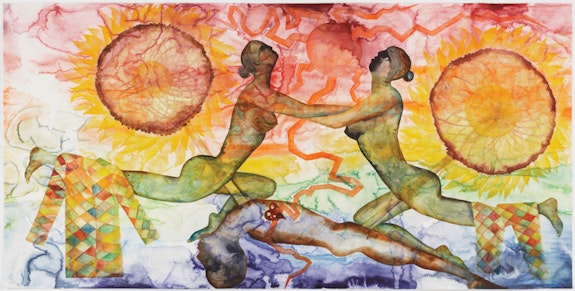ArtSeen
Francesco Clemente: Works 1978-2018
Francesco Clemente, A History of the Heart in Three Rainbows (III), 2009. Watercolor on paper, 73 1/9 x 149 3/4 inches. Courtesy the artist.
New York
Brant Foundation Art Study CenterNovember 12, 2018 – April 1, 2019
William Blake’s poem “The Sick Rose” describes the destructive power of a “dark secret love” on a flower’s “crimson joy.” This nefarious force is both eroticized and made phallic in being depicted as an “invisible worm.” Blake understood that death shadows innocence, although in his shorter poems this relationship is rarely presented so bleakly—less as an encounter and more like a contaminating disease. Yet the point of “The Sick Rose” is not that eroticism corrupts, but that it has been sullied by obsession, secrets, and shame. In Francesco Clemente’s small rendering (1979 – 80) of Blake’s eight-line, thirty-four word poem, currently on display at the Brant Foundation Art Study Center in Greenwich, Connecticut, the words and images blur red and pink, and they may even throb, in an attempt to capture this passion that undoes what it possesses.
Clemente is best known for being part of the brash group of Neo-Expressionists who swaggered across the 1980s New York City art (and finance) landscape. Yet only a handful of his paintings from this period are included at the Brant Foundation, and thickly applied oils aren’t the strength of this exhibition. Rather, the revelations are the watercolors and frescos, and, just as importantly, the images they render—a mix of abstract and figurative, spiritual and erotic. In a near perfect fit between form and content, the inherent translucency of the watercolor medium means that the viewer is looking both at these works and through them, which is in keeping with the sense of transcendence they aim to achieve.
Clemente is nothing but ambitious in the size and concerns of his work. The three-panel fresco Principles of the Path (2001) signals this immediately with its Buddhist-inspired title and its dimensions: more than ten feet tall by almost twenty feet wide. The path referred to is the set of guidelines and stages for achieving enlightenment (nirvana) and escaping the endless cycle of death and rebirth (samsara). Clemente has given this progression a tantric dimension, as he has in a number of works throughout the exhibition. In the first panel, a golden stalk is held aloft through an oval—viz., vulvic—hole in a pink curtain; in the second panel a heart-shaped incision in the curtain reveals copulating male and female genitalia; in the third panel, cut-out eyes and a slender smile float across the painted pink surface. A blissed-out non-self is certainly one definition of nirvana.
Although in the West tantric practice has become associated with sexual intercourse, and although the works at the Brant Foundation feature lots of female genitalia and a smattering of erect penises, in Buddhist and Hindu traditions, ritualistic copulation functions primarily as a metaphor for self-generated energies. The entwined female and male figures seen on Hindu temples or in Buddhist statuary are devotional figures, not pornographic ones. A History of the Heart in Three Rainbows (2009) consists of eleven enormous watercolors that trace another enlightenment journey in almost Blakean allegorical fashion—right down to the thorns that also appear in Clemente’s version of “The Sick Rose” as well as in Blake’s “The Garden of Love” in which “Priests in black gowns, were walking their rounds, / And binding with briars, my joys and desires.” The room-sized installation follows the heart through a variety of entrapments before achieving liberation.
Like Blake, Clemente wants to free sex from shame. Drawing on Buddhist and Hindu influences, and mixing in his own unique creative vision, he has created an entire cosmology from erotic union. This is what the first floor of the Brant Foundation seeks to teach. It also contains Clemente’s collaborations with poets such as Allen Ginsberg, Robert Creeley, and Gregory Corso. Clemente shares with these writers an interest in the mundane and something larger, be it religion, death, or a reimagined sense of self. Furthermore, the unique touch his watercolors display might be compared to a form of writing as the brush moves with precision and sensitivity across the sometimes enormous sheets of paper. Clemente’s imagery nearly always functions like the figurative language of poetry, recognizable while simultaneously signifying something else.
Consistent across the work on both floors is a centripetal compositional approach. Wheel of Dharma (1983) might be the most literal version with its central, organizing circle. In the more recent White Flags I (2015), birds swoop around a perforated heart. My House (1982), also on the second floor, features a spiral staircase joining domestic and artistic spaces. Name (1983), one of the most recognizable works in the exhibition, is a swirl of faces within faces. Even the famous portrait of his wife, Alba Clemente (1997), is visually oriented around the gold orbs of her arm bracelet and the slightly oversized eyes that appear in other portraits as well. Stepping away from the wheel of endless reincarnation is one of the goals of Buddhism and Hinduism. Clemente engages with this notion in an art that seeks to peer both through and beyond, while remaining rooted in the flesh of this world.



